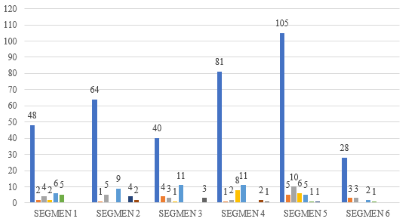Road Damage Analysis using Surface Distress Index (SDI) and Its Handling on Provincial Road Babat - Jombang (STA 7+000 - 12+500)
DOI:
https://doi.org/10.24036/cived.v11i3.646Keywords:
Road Damage, SDI (Surface Distress Index) Method, Road Damage ManagementAbstract
The Babat - Jombang road is often traveled by highly loaded vehicles because there are large industries along this section. In addition, the road is damaged by weather and poor subgrade conditions. Thus, resulting in road damage that can interfere with user comfort. Therefore, road damage analysis research was conducted on Babat - Jombang Road (STA 7+000 - 12+500). Road damage analysis in this study using the SDI method. The SDI (Surface Distress Index) method is a road performance scale obtained from visual observations of road damage that occurs in the field. The SDI method is a method that produces an SDI value obtained from the percentage of crack area, crack width, number of holes per 100 m, and the depth of the ruts. From this research, the types of damage on Babat - Jombang Road (STA 7+000 - 12+500) are the hole damage area of 0.11%, longitudinal cracks of 12.05%, transverse cracks of 0.17%, edge cracks of 0.29%, crocodile skin cracks of 79, 66%, shoulder joint cracking by 0.0015%, ruts by 1.48%, bleeding by 1.1%, ravelling by 2.61%, surface layer flaking by 0.13%, patches by 0.26%, upheavel by 0.51%, shoving by 1.6%. Road condition assessment using SDI method shows 87.27% in good condition and 12.73% in moderate condition. Handling carried out is leveling, sealing, hot aggregate sprinkle, and patching holes.
Downloads
References
Peraturan Pemerintah RI, Peraturan Pemerintah Republik Indonesai tentang Jalan (Undang-Undang Nomor 38 Pasal 1 Ayat 1 Tahun 2004), vol. 1, no. 1. 2004, p. 3.
F. Yudaningrum and I. Ikhwanudin, “Identifikasi Jenis Kerusakan Jalan (Studi Kasus Ruas Jalan Kedungmundu-Meteseh),” Teknika, vol. 12, no. 2, 2017.
P. Studi, S. Teknik, F. Teknik, and U. N. Surabaya, “Penentuan Prioritas Penanganan Kerusakan Jalan Kabupaten di Lamongan dengan Metode Analytical Hierarchy Process ( AHP ) Nanda Putri Ning Tias Ari Widayanti”.
H. & Sholichin, “Perbandingan Evaluasi Tingkat Kerusakan Jalan Berdasarkan Metode Bina Marga dan PCI (Pavement Condition Index) pada Ruas Jalan Sampang-Ketapang STA. 23+800-29+100 Provinsi Jawa Timur,” J. Ilm. Tek. Sipil, vol. 8, no. 1, pp. 1–9, 2022.
M. Muhaimin, “Analisis Kerusakan Jalan Berdasarkan Metode Surface Distress Index (Sdi) Studi Kasus: Jalan Meranti Kota Pekanbaru Provinsi Riau,” Universitas Lancang Kuning, 2022.
C. Arifi, “Analisis Kerusakan Permukaan Jalan Batas Kota Singkawang - Bengkayang Dengan Metode Surface Distress Index (SDI) Dan Metode Pavement Condition Index (PCI),” pp. 1–7, 2023.
F. L. Desei, Y. Kadir, and A. Z. Ende, “Evaluasi Kerusakan Jalan Menggunakan Metode Surface Distress Index dan International Roughness Index,” Konstruksia, vol. 15, no. 1, p. 67, 2023, doi: 10.24853/jk.15.1.67-77.
C. M. Yusup, “Perbandingan Biaya Pemeliharaan Terhadap Tingkat Kerusakan Jalan Menggunakan Metode Surface Distress Index (Sdi) Dan Bina Marga (Studi Kasus: Ruas Jalan Cisaat--Situgunung Sta. 0+ 400--5+ 400 Kabupaten Sukabumi),” Universitas Muhammadiyah Sukabumi, 2020.
I. N. Yastawan, D. M. P. Wedagama, and I. M. A. Ariawan, “Penilaian Kondisi Jalan Menggunakan Metode SDI (Surface Distress Index) Dan Inventarisasi Dalam GIS (Geographic Information System) Di Kabupaten Klungkung,” J. Spektran, vol. 9, no. 2, p. 181, 2021.
Presiden Republik Indonesia, Peraturan Menteri Pekerjaan Umum Republik Indonesia. 2011.

Downloads
Published
Issue
Section
License
Copyright (c) 2024 Kevin Daffarial Prasodjo Daffarial Prasodjo, Ibnu Sholichin, Fithri Estikhamah

This work is licensed under a Creative Commons Attribution 4.0 International License.

